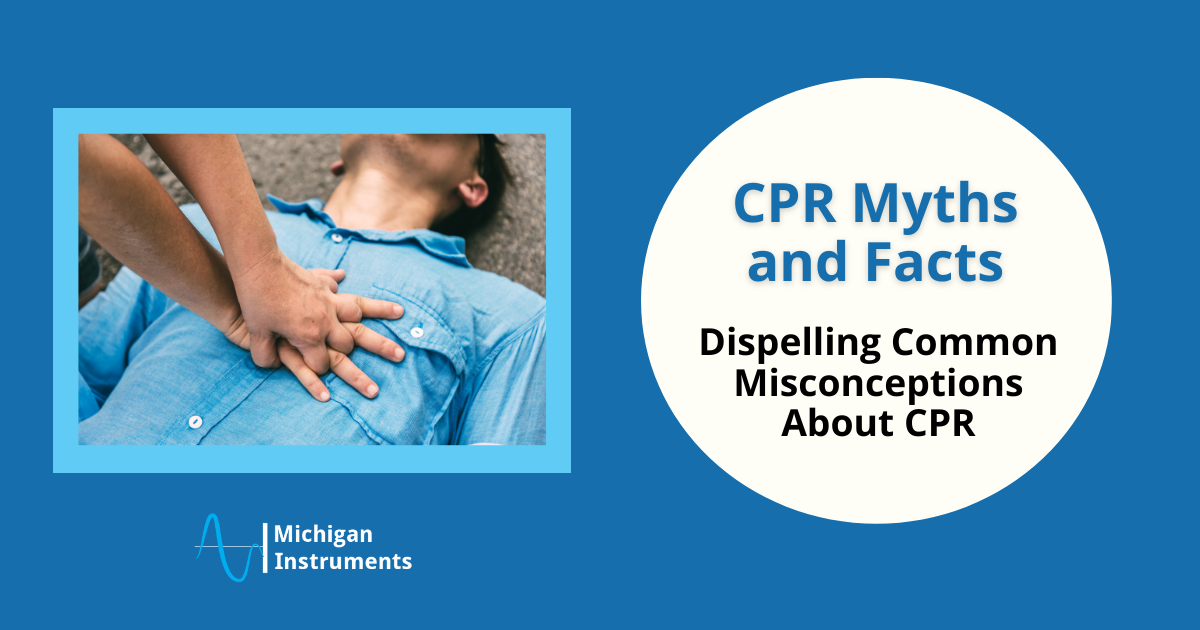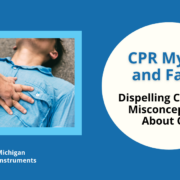
Cardiopulmonary Resuscitation, better known simply as CPR, isn’t just a medical procedure; it’s a beacon of hope.
There are over 350,000 cardiac arrests occurring outside the hospital annually in the United States alone. The need for quick and effective CPR has never been more critical.
However, amidst the importance of CPR, many myths and misconceptions have emerged, casting shadows on the clarity of the practice. Below, we outline important facts about CPR and dispel some common misconceptions surrounding CPR.
Highlighting The Impact of Bystander CPR
Bystander CPR significantly increases survival of cardiac arrest, emphasizing the crucial role of immediate intervention by good samaritans in saving lives. Of the 350,000 yearly out-of-hospital cardiac arrests (OHCA), The American Heart Association has found that the most common occurrence is in homes or residences (73.4%), followed by public settings (16.3%) and nursing homes (10.3%).
These statistics highlight the importance of people of all walks of life understanding and performing CPR, as emergencies can happen anywhere at any time. If performed immediately, CPR can double or triple the chance of survival from an out of hospital cardiac arrest.
Statistics Support the Importance of Swift CPR
Did you know that in one year alone, 436,000 Americans die from cardiac arrest?
Globally, cardiac arrest claims more lives than colorectal cancer, breast cancer, prostate cancer, influenza, pneumonia, auto accidents, HIV, firearms, and house fires combined.
The impact of immediate CPR cannot be overstated. If performed promptly, CPR can double or even triple the chances of survival of someone suffering an out-of-hospital cardiac arrest.
This again highlights the critical role of bystanders in bridging the gap between life and death, and emphasizes the need for widespread CPR training and awareness.
Myths Surrounding CPR Could Cost Someone’s Life
There are many myths and misconceptions about performing CPR, and with so many heart attacks and cardiac events happening outside of the hospital, believing these myths could cost a life.
Myth 1: Only Medical Professionals Can Perform CPR Effectively.
It is a common misconception that only medical professionals can perform CPR effectively.
However, the fact is that bystander CPR significantly increases survival rates. Providing immediate intervention plays a crucial role in saving lives.
Myth 2: CPR Guarantees the Revival of the Heart.
One of the most important facts about CPR is that it aims to sustain the function of vital organs and maintain blood circulation until advanced medical care becomes available—but there is no guarantee that the heart will recover.
This further highlights the importance of quick and efficient CPR to offer the highest likelihood of survival.
Myth 3: Incorrect CPR Technique Can Cause Harm.
The truth is that performing CPR, correctly or incorrectly, can cause damage to the ribs. However, the risk of harm from utilizing incorrect CPR techniques is greatly outweighed by the potential benefits of immediate intervention.
Myth 4: CPR Requires Mouth-to-Mouth Resuscitation.
This is a common myth, but it is important to understand that hands-only CPR offers a simplified yet effective approach, especially for adult victims of cardiac arrest. Using a hands-only approach to CPR reduces barriers to bystander intervention.
Myth 5: CPR is Exclusive to Adults.
Cardiac arrest can affect individuals of all ages, so it’s important to know that CPR techniques can be tailored to different age groups.
Being familiar with the differences between adult and child CPR techniques is crucial to optimize outcomes for the individual experiencing a cardiac episode, regardless of age.
Performing CPR on a child differs from adults due to anatomical and physiological distinctions. With a child, emphasis on proper compression depth and the use of breaths is crucial.
Myth 6: You Should Cease CPR if No Signs of Improvement are Evident.
Signs of improvement can be difficult to catch, so performing continuous CPR is crucial. You should always continue performing CPR until professional medical assistance arrives, as the sustained circulation of CPR enhances the likelihood of survival, even in the absence of immediate improvement.
The Truth: CPR Saves Lives
By dispelling common misconceptions surrounding CPR and spreading the truth about these myths, we can pave the way for more informed and empowered communities who are ready to respond effectively in life-threatening situations.
The truth is that in an emergency, every second counts, and each action holds the potential to save a life.
Michigan Instruments provides CPR chest compression machines that deliver the highest quality care during the treatment of cardiac arrest. They are easy to use and are light enough to be easily incorporated into a hospital’s “crash cart” set up.
Setting up the unit takes seconds and requires minimal interruption to manual CPR. With the Life-Stat, the chest compressor and ventilator are built into the unit, providing your medical team with a totally hands-free, automated CPR solution.
With the only CPR device on the market today that meets the AHA CPR guidelines for both chest compression and ventilation, trust that your patients are always in good hands with Michigan Instruments.
CPR Devices You Can Count On. Learn More.
Michigan Instruments provides state-of-the-art CPR Devices that can revolutionize the way your facility operates. These innovations enhance medical training and emergency response tactics, ensuring proficiency and quick response times.
Contact Michigan Instruments to learn how our devices can assist your facility with saving lives.




